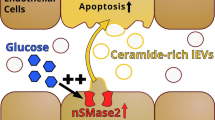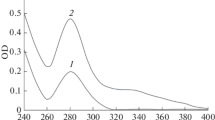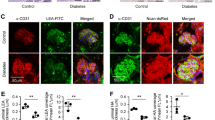Abstract
It has been demonstrated in vivo that lipid glycation products such as Amadori-glycated phosphatidylethanolamine (Amadori-PE) accumulate in the plasma of diabetic humans and animals, but how lipid glycation products are formed under hyperglycemic conditions are not clear. We sought to clarify the occurrence of lipid glycation and its relationships with lipid peroxidation and protein glycation during the development of hyperglycemia using the streptozotocin (STZ)-induced diabetic rat model. A significant increase in Amadori-PE was observed in STZ rats 7 days after STZ treatment, and Amadori-PE (especially 18:0–20:4 Amadori-PE) was found at high levels in the blood and in organs that are strongly affected by diabetes, such as the kidney. Significant changes in Amadori-PE appeared to occur prior to changes in levels of oxidized lipids, which increased after 21–28 days. In addition, accumulation of Nε-(carboxymethyl)lysine (CML), a protein glycation product, proceeded somewhat more slowly and moderately than that of Amadori-PE, suggesting that Amadori-PE and CML are early and advanced glycation products, respectively. Our results suggest that Amadori-PE may be a useful predictive marker for hyperglycemia, particularly in the early stages of diabetes. Similar speculations have been made from previous human studies, but this study provides a direct evidence to support the speculations in rat study.







Similar content being viewed by others
Abbreviations
- 1,5-AG:
-
1,5-Anhydroglucitol
- ALT:
-
Alanine aminotransferase
- Amadori-PE:
-
Amadori-glycated phosphatidylethanolamine
- AST:
-
Aspartate aminotransferase
- CL:
-
Chemiluminescence
- CML:
-
Nε-(carboxymethyl)lysine
- HbA1c :
-
Hemoglobin A1c
- LC:
-
Liquid chromatography
- MRM:
-
Multiple reaction monitoring
- MS/MS:
-
Tandem mass spectrometry
- NFPA:
-
Nonafluoropentanoic acid
- NLS:
-
Neutral loss scanning
- PCOOH:
-
Phosphatidylcholine hydroperoxide
- PE:
-
Phosphatidylethanolamine
- PL:
-
Phospholipid
- RBC:
-
Red blood cells
- STZ:
-
Streptozotocin
- TBARS:
-
Thiobarbituric acid reactive substances
- T-cho:
-
Total cholesterol
- TAG:
-
Triacylglycerol
References
Ahmed N, Thornalley PJ (2007) Advanced glycation end products: what is their relevance to diabetic complications? Diabetes Obes Metab 9:233–245
Bucala R, Makita Z, Koschinsky T, Cerami A, Vlassara H (1993) Lipid advanced glycosylation: pathway for lipid oxidation in vivo. Proc Natl Acad Sci USA 90:6434–6438
Ravandi A, Kuksis A, Marai L, Myher JJ, Steiner G, Lewisa G, Kamido H (1996) Isolation and identification of glycated aminophospholipids from red cells and plasma of diabetic blood. FEBS Lett 381:77–81
Lertsiri S, Shiraishi M, Miyazawa T (1998) Identification of deoxy-d-fructosyl phosphatidylethanolamine as a non-enzymic glycation product of phosphatidylethanolamine and its occurrence in human blood plasma and red blood cells. Biosci Biotechnol Biochem 62:893–901
Higuchi O, Nakagawa K, Tsuzuki T, Suzuki T, Oikawa S, Miyazawa T (2006) Aminophospholipid glycation and its inhibitor screening system: a new role of pyridoxal 5′-phosphate as the inhibitor. J Lipid Res 47:964–974
Nakagawa K, Oak JH, Higuchi O, Tsuzuki T, Oikawa S, Otani H, Mune M, Cai H, Miyazawa T (2005) Ion-trap tandem mass spectrometric analysis of Amadori-glycated phosphatidylethanolamine in human plasma with or without diabetes. J Lipid Res 46:2514–2524
Ravandi A, Kuksis A, Shaikh NA (1999) Glycated phosphatidylethanolamine promotes macrophage uptake of low density lipoprotein and accumulation of cholesteryl esters and triacylglycerols. J Biol Chem 274:16494–16500
Ravandi A, Kuksis A, Shaikh NA (2000) Glucosylated glycerophosphoethanolamines are the major LDL glycation products and increase LDL susceptibility to oxidation: evidence of their presence in atherosclerotic lesions. Arterioscler Thromb Vasc Biol 20:467–477
Oak JH, Nakagawa K, Miyazawa T (2000) Synthetically prepared Amadori-glycated phosphatidylethanolamine can trigger lipid peroxidation via free radical reactions. FEBS Lett 481:26–30
Shoji N, Nakagawa K, Asai A, Fujita I, Hashiura A, Nakajima Y, Oikawa S, Miyazawa T (2010) LC–MS/MS analysis of carboxymethylated and carboxyethylated phosphatidylethanolamines in human erythrocytes and blood plasma. J Lipid Res 51:2445–2453
Folch J, Lees M, Sloane-Stanley GH (1957) A simple method for the isolation and purification of total lipids from animal tissues. J Biol Chem 226:497–509
Rose HG, Oklander M (1965) Improved procedure for the extraction of lipids from human erythrocytes. J Lipid Res 6:428–434
Miyazawa T, Suzuki T, Fujimoto K, Yasuda K (1992) Chemiluminescent simultaneous determination of phosphatidylcholine hydroperoxide and phosphatidylethanolamine hydroperoxide in the liver and brain of the rat. J Lipid Res 33:1051–1059
Kinoshita M, Oikawa S, Hayasaka K, Sekikawa A, Nagashima T, Toyota T, Miyazawa T (2000) Age-related increase in plasma phosphatidylcholine hydroperoxide concentrations in normal subjects and patients with hyperlipidemia. Clin Chem 46:822–828
Ohkawa H, Ohishi N, Yagi K (1979) Assay for lipid peroxides in animal tissues by thiobarbituric acid reaction. Anal Biochem 95:351–358
Teerlink T, Barto R, Ten Brink HJ, Schalkwijk CG (2004) Measurement of Nepsilon-(carboxymethyl)lysine and Nepsilon-(carboxyethyl)lysine in human plasma protein by stable-isotope-dilution tandem mass spectrometry. Clin Chem 50:1222–1228
Bartlett GR (1957) Colorimetric assay methods for free and phosphorylated glyceric acids. J Biol Chem 226:497–509
Obsil T, Amler E, Obsilová V, Pavlícek Z (1999) Effect of aminophospholipid glycation on order parameter and hydration of phospholipid bilayer. Biophys Chem 80:165–177
Levi V, Villamil Giraldo AM, Castello PR, Rossi JP, González Flecha FL (2008) Effects of phosphatidylethanolamine glycation on lipid-protein interactions and membrane protein thermal stability. Biochem J 416:145–152
Simões C, Simões V, Reis A, Domingues P, Domingues MR (2010) Oxidation of glycated phosphatidylethanolamines: evidence of oxidation in glycated polar head identified by LC-MS/MS. Anal Bioanal Chem 397:2417–2427
Tourrel C, Bailbe D, Meile MJ, Kergoat M, Portha B (2001) Glucagon-like peptide-1 and exendin-4 stimulate beta-cell neogenesis in streptozotocin-treated newborn rats resulting in persistently improved glucose homeostasis at adult age. Diabetes 50:1562–1570
Ramesh B, Pugalendi KV (2005) Antihyperlipidemic and antidiabetic effects of umbelliferone in streptozotocin diabetic rats. Yale J Biol Med 78:189–196
Geethan PK, Prince PS (2008) Antihyperlipidemic effect of d-pinitol on streptozotocin-induced diabetic Wistar rats. J Biochem Mol Toxicol 22:220–224
King R, Fernandez-Metzler C (2006) The use of Qtrap technology in drug metabolism. Curr Drug Metab 7:541–545
Helen Vlassara H, Uribarri J (2004) Glycoxidation and diabetic complications: modern lessons and a warning? Rev Endocr Metab Dis 5:181–188
Nagai R, Fujiwara Y, Mera K, Motomura K, Iwao Y, Tsurushima K, Nagai M, Takeo K, Yoshitomi M, Otagiri M, Ikeda T (2008) Usefulness of antibodies for evaluating the biological significance of AGEs. Ann N Y Acad Sci 1126:38–41
Thornalley PJ, Battah S, Ahmed N, Karachalias N, Agalou S, Babaei-Jadidi R, Dawnay A (2003) Quantitative screening of advanced glycation endproducts in cellular and extracellular proteins by tandem mass spectrometry. Biochem J 375:581–592
Kang KS, Yamabe N, Kim HY, Yokozawa T (2008) Role of maltol in advanced glycation end products and free radicals: in vitro and in vivo studies. J Pharm Pharmacol 60:445–452
Acknowledgments
A part of this study was supported by KAKENHI (S) (20228002, to T. M.) of JSPS, Japan.
Author information
Authors and Affiliations
Corresponding author
Electronic supplementary material
Below is the link to the electronic supplementary material.
11745_2011_3588_MOESM1_ESM.pdf
Fig. S1 Time course of changes in total PE glycation rate (mol% of PE) in (A) plasma, (B) RBC, (C) liver, (D) kidney, (E) pancreas, (F) cerebrum, and (G) cerebellum. Values are means ± SD (n=6; *P < 0.05 and **P < 0.01). White circles represent control rats, and black circles represent STZ rats. (PDF 44.4 kb)
11745_2011_3588_MOESM2_ESM.pdf
Fig. S2 Glycation rates of Amadori-PE molecular species (mol% of PE) 28 days after STZ injection. (A) plasma, (B) RBC, (C) liver, (D) kidney, (E) pancreas, (F) cerebrum, and (G) cerebellum. Values are means ± SD (n = 6; *P < 0.05 and **P < 0.01). White bars represent control rats, and black bars represent STZ rats. (PDF 27.3 kb)
About this article
Cite this article
Sookwong, P., Nakagawa, K., Fujita, I. et al. Amadori-Glycated Phosphatidylethanolamine, a Potential Marker for Hyperglycemia, in Streptozotocin-Induced Diabetic Rats. Lipids 46, 943–952 (2011). https://doi.org/10.1007/s11745-011-3588-3
Received:
Accepted:
Published:
Issue Date:
DOI: https://doi.org/10.1007/s11745-011-3588-3




